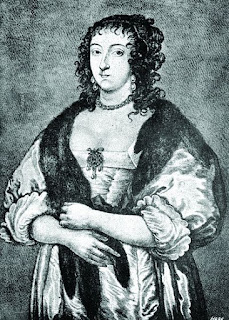THE GHOST OF MARY HOWARD,
MURDEROUS DENIZEN OF FITZFORD HOUSE
|
| Devon Fields by Emma Hunter. A Miniature in Oils. |
Think of Devonshire, and a series of images come immediately to mind. This is Ambrosia country, painted green with peaceful rolling hills, pleasant farms and cosy cottages. The coast is dotted with picturesque fishing villages, beautiful beaches and smart resorts. It is beautiful, in a gentle, safe, very English kind of way.
But then along comes Dartmoor, which is anything but these things. Filled with darkly brooding landscapes, magnificent tors and barren wastes, it is a place of melodrama and mystery. A place where it is all too possible to believe in things that should not be.
 |
| Pewtor at Sunset |
Few in Tavistock mourned his passing, for John was bad to the bone. Having inherited vast estates on the border of Devon and Cornwall, he made the most of living above the law. Having already murdered one man during a drunken squabble, his best friend Sir Nicholas Slanning, he killed a second near London before stabbing himself in the chest.
As was the way in those days, Mary was taken from her remaining family and made a ward of court. In all essence, she was sold to the highest bidder, that they might marry her estates and claim them for their own. As such, she found herself wed at the tender age of twelve to the Earl of Northumberland's brother. There was of course no love involved in the arrangement. The Earl had bought the role of "protector" of the girl due to her great wealth. His brother owing Earl Percy vast sums of money, he was ensuring a way of having the debts repaid.
In fact, the husband died without Mary ever seeing him again. Still a child, their marriage happily unconsummated, she heard the news from afar that he had passed away. It was to be the first of four marriages, only one of which was actually made for love. Although one of these unions ended with divorce, the other three concluded with poor Mary being widowed.
 |
| The Much-Maligned Mary Howard |
Such misfortune might have made local people pity her, but they did not. The Fitz name had been blackened irrevocably by her father's actions and now people suspected the same of her.
"Afterall, the apple doesn't fall far from the tree," they would whisper. "Three husbands dead....and now also a child in the grave. Perhaps Mary inherited murderous passions alongside her parent's wealth."
All of which explains her presence as a most terrible apparition.
Each night, Mary's corpse leaves Fitzford Gatehouse in Tavistock. Her carriage is composed of the bones of her murdered husbands and children. It is pulled by skeletal stallions, whipped into a frenzy by a headless horseman.
Any who witness it race towards another family possession, the ruined castle at Okehampton, are cursed to die themselves. But why, you might ask, must Mary's ghost make this nightly journey?
It is punishment for her earthly crimes. She is condemned to enact a fruitless task, to pluck bare the castle mound of grass, one blade at a time, before sunrise. Only when the chore is complete will her soul know eternal rest, but it is of course a quite impossible mission. She therefore repeats the journey each night, as she has for the past 346 years. It is a journey she is doomed to repeat until the end of time.
My Ladye hath a sable coach,
And horses tow and four;
My ladye hath a black blood-hound
That runneth on before.
My ladye's coach hath nodding plumes,
The driver hath no head;
My ladye is an ashen white,
As one that long is dead.
 |
| The Gatehouse...All That Remains of the Fitzford Estate |
 |
| Okehampton Castle Ruins |
A Postscript to this Tale...
There are two interesting footnotes to this story. The first involves my time managing The Royal Standard public house in Mary Tavy. The moorland village lies astride the former King's Highway, the one-time coaching route linking Tavistock to Okehampton. Should the tale of Marys spectral coach be true, she might be seen from the pub's windows late at night.Of course, I never saw anything of the sort but the building was haunted by a ghostly woman. Not only I saw her, so did my daughter Charlotte, a barmaid named Katrina and an old flame of mine, Jennifer from Manchester. The impression I got each time was fleeting: more a hint of a woman, than a woman herself. The one thing I did notice was that she was clothed in gold dress, possibly a ball gown. Why such an elegant personage should haunt a tin miner's drinking house is unknown.
One of my regulars, the resident of a neighbouring cottage, told me the pub was known to be haunted in this way. She said it was believed that the ghost was Lady Tavistock. In other words, none other than the infamous Mary Howard!
Before ever I'd taken the pub on, I began writing a book called The Children of Powerful Men. It is a Celtic crime novel, set upon Dartmoor and the romantic Cornish coast, and it features an array of characters from both the history and folklore of the area. By serendipity, fate or coincidence, Sir John Fitz, his victim Nicholas Slanning, and poor Mary's mother Brigit all play prominent roles. Should you wish to give it a go, it is available on Kindle at The Children of Powerful Men

























